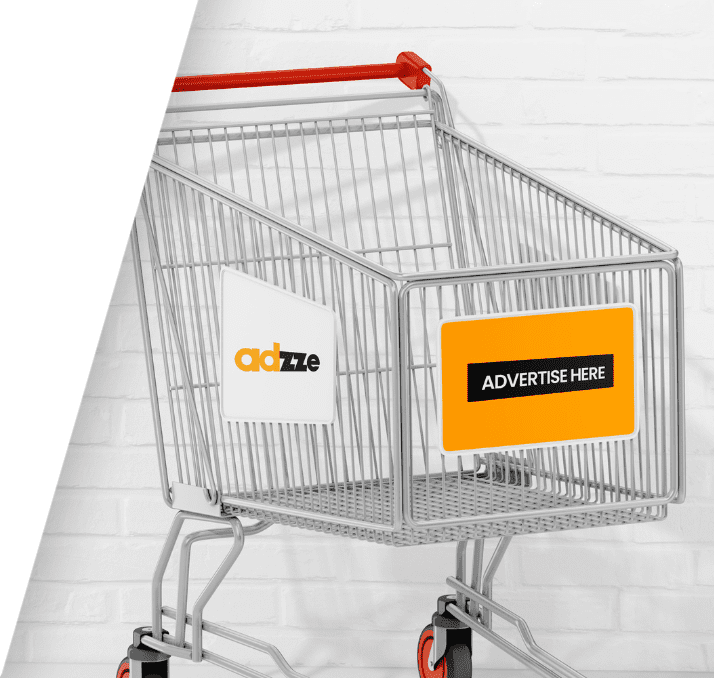
What if your brand was seen during every grocery run? Shopping cart advertising gets your message right into the hands of local shoppers. The best part? Your brand rides along for 30-45 minutes of undivided attention. Ready to turn every aisle into your ad space?

Grocery Cart Advertising is an in-store strategy where ads are placed on grocery carts, such as on handles or baby seats. Shoppers spend an average of 30–45 minutes in the store, providing substantial time for the ad to engage them. With hyper-local targeting, advertisers can choose stores based on DMA or Zip Code, ensuring precise audience reach. This format offers high visibility as the cart accompanies the shopper throughout their trip, creating multiple touchpoints during their visit.
Impacts of Grocery Cart Advertising
This advertising method delivers significant reach, with impressions ranging from 250,000 to 420,000 per month per store. It ensures repetitive exposure as shoppers frequently look at the cart during their trip. This prolonged engagement leads to stronger brand recall compared to other OOH formats like billboards. Furthermore, the local targeting capability makes it an effective tool for connecting with specific communities, enhancing its impact for businesses dependent on local customers.
Grocery cart advertising offers a unique and impactful way to engage consumers while they shop. By integrating creative elements like QR codes, grocery cart ads can transform the shopping experience into a memorable brand interaction.
Grocery Cart Panels
Grocery cart panel advertising transforms the side panels of the cart into eye-catching branded displays. These ads stay in the shopper’s line of sight as they navigate the store, ensuring maximum visibility and repeated exposure throughout their visit.
Specifics:
Best For:
Brands seeking to engage shoppers throughout their store visit. Perfect for long-term campaigns aimed at brand building or targeting specific product categories.

Grocery Cart Advertising is cost-effective, with CPMs ranging from $2 to $7, making it an affordable option compared to traditional billboards. It excels in hyper-local targeting, ensuring messages reach relevant audiences. The design flexibility allows businesses to create engaging ads tailored to their goals, ensuring strong connections with shoppers.
In summary, grocery cart advertising is a strategic, cost-effective way for businesses to build brand awareness in their local communities. It offers repetitive exposure, precise targeting, and high visibility, all at a fraction of the cost of traditional billboards.
Evaluating the impact of grocery cart advertising involves analyzing reach, cost efficiency, and consumer interactions. Here’s how it works:
These are just a few examples of how grocery cart advertising can be leveraged across different industries to achieve impactful results.
Example: A snack brand could place ads on grocery carts promoting a new product that’s available in-store. The ad might direct customers to find the item in a specific aisle or provide a discount code, driving immediate action.
Benefit: By aligning the ad with the consumer’s current shopping mission, the brand can encourage impulse purchases, leveraging proximity to products
Example: A local plumber or HVAC company can use grocery cart ads to target homeowners in the area. Since these services are often needed on short notice, frequent exposure to the company’s name and contact info on grocery carts ensures that when a homeowner experiences an issue, they’re more likely to remember and call the advertised service.
Benefit: Continuous exposure builds brand recall, and since the audience is local, it’s highly targeted.
Example: A nearby pharmacy or urgent care clinic can promote its services to shoppers by emphasizing proximity, convenience, or quick wait times. Shoppers who visit the grocery store are often from the surrounding area, making this ad placement relevant for healthcare providers.
Benefit: Healthcare services are essential, and proximity to a shopper’s home increases the likelihood of them considering the service when needed.
Example: A real estate agent can use grocery cart ads to build awareness of their services in specific neighborhoods. The ad could feature testimonials or information about recently sold homes to establish credibility and encourage homeowners considering a sale to reach out.
Benefit: Local targeting ensures that the right audience sees the agent, reinforcing their presence in the community and increasing trust.

Rogers Behavioral Health Targets Recruits with Pizza Box Topper Campaign

Kashi’s Bear Naked Granola Takes Over Coffee Shops with Coffee Sleeves

Centura Health Uses Hand Sanitizing Stations to Promote COVID-19 Vaccination

MoDOT Delivered a High-Impact Campaign with Pizza Toppers

Champlain College Delivers Career Growth with Pizza Box Toppers




A typical campaign costs between $2 and $7 CPM (cost per thousand impressions), providing an affordable and high-impact alternative to traditional billboards.
Distribution can be tracked through partnerships with grocery stores, which report on traffic metrics and estimated reach. Adding QR codes or unique promo codes to ads allows for further tracking of shopper engagement.
Yes, beauty salon advertising is highly customizable. Brands can tailor wall posters, counter cards, and take-one brochures to reflect their unique messaging, branding, and promotional goals. Customization helps ensure that the ads align with the salon’s aesthetic while resonating with its clientele.
While response rates depend on the ad’s design and relevance, the prolonged exposure time (30–45 minutes) and frequent glances at the cart significantly increase the likelihood of recall and engagement.
Yes, ads can be customized with vibrant visuals, QR codes, and targeted messages, allowing businesses to create highly engaging and audience-specific campaigns.
Absolutely. By incorporating QR codes, URLs, and digital offers, Grocery Cart Advertising bridges the gap between in-store engagement and online conversions, making it a powerful tool for digital businesses.
Grocery Cart advertising offers a unique blend of hyper-local targeting, high visibility, and cost-effectiveness, making it an underrated tool for advertisers looking to reach specific audiences. Ready to explore how this method can drive results for your brand? Request our Media Kit today to explore the possibilities further.





All rights reserved 2024